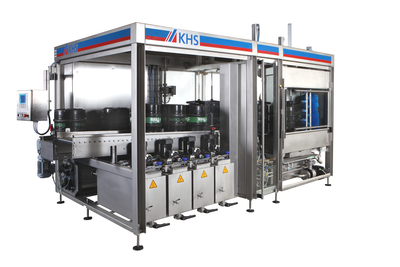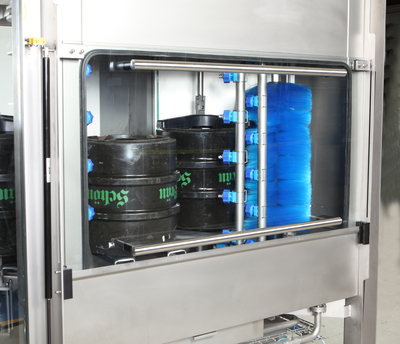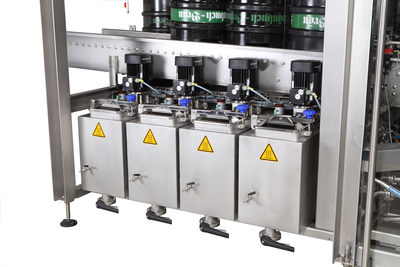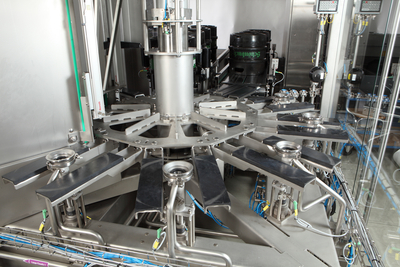
Innovative Keg Technology for Small and Medium-Sized Companies
Compact keg washer and racker in container format
Rainer Deutschmann* The market leader of keg technology has now introduced a new machine to the world of kegging: the Innokeg Till CombiKeg. This new development is an extremely compact keg washing and racking machine that cleans kegs inside and out, racks them, and has integrated into its cladding up to five media tanks, all controls, and the infeed and discharge conveyors. The Innokeg Till CombiKeg has been designed so that it fits into one container and is supplied ready for action as a Plug & Produce machine, resulting in less time required for installation and commissioning, among other things. With a capacity of 60 to 90 kegs an hour, the Innokeg Till CombiKeg nicely complements the existing KHS keg family portfolio. It is also based on the principle of rotary processing that KHS has been operating and further developing for several decades now, the specific advantage of which lies in the small amount of space needed for the installation of this cyclic operation machine. Output of up to 90 kegs an hour The target group for the Innokeg Till CombiKeg consists in essence of small to medium-sized businesses in the brewing, soft drinks, mineral water, fruit juice, and wine sectors whose estimated maximum kegging output, both now and in the future, will most likely not exceed 90 kegs an hour. If such companies should find themselves needing to produce more than 90 kegs an hour, KHS recommends that they invest in the Innokeg Till Transomat inline machine. With this, increases in capacity can be met simply by integrating additional Innokeg Till Transomat keg washing and racking lines into the overall system. User-friendly design Where the keg infeed and discharge areas on classic inline machines are kept very separate, on the Innokeg Till CombiKeg these are right next to each other and thus arranged with the utmost ease of operation in mind. * Kegging Global Product Account Manager, KHS GmbH, Kriftel. Phone: +49 (6192) 491-130 This means that just one operator can place the empty kegs onto the infeed conveyor and, without having to walk any distance at all, subsequently remove and palletize the racked kegs straight off the discharge conveyor. Another advantage is that the machine's principle of rotary processing means comparably fewer keg conveying segments are necessary. This results in less time being needed for installation, less space being used, and reduced investment costs for the entire system. Modular concept Another exceptional feature of the Innokeg Till CombiKeg is that the system is modular, enabling a great number of possible configuration options. The standard Innokeg Till CombiKeg R 3/1 machine has three washing heads and one racking head, a classic, pressure-dependent racking system, and return gas control. The maximum output of this model is 60 kegs an hour. Depending on the product and capacity required, the Innokeg Till CombiKeg also comes in an R 5/1 version with five washing heads and one racking head. In place of the classic return gas control system, KHS' patented Direct Flow Control or DFC filling technology has been incorporated. DFC can also be integrated into the standard machine at a later stage. Equipped with the DFC filling system, the Innokeg Till CombiKeg R 5/1 is able to output 50% more than its counterpart the R 3/1, thus washing and racking up to 90 kegs each hour. Another benefit is that the diverse media required by the specific operating conditions is supplied from caustic, acid, mixed water, or hot water tanks integrated into the enclosed frame of the Innokeg Till CombiKeg. Exterior keg washer part of the package One option on the Innokeg Till CombiKeg is to include the exterior keg washer in the housing, again cutting down on the amount of space the system requires. If the exterior washer is not started, the space earmarked remains available. A retrofit is possible at any time. The wide range of peripheral equipment that can be inserted downstream of the keg washing and racking process, such as keg scales, a keg turner, keg capper, camera, and so on and so forth, also demonstrates just how flexible the keg line can be. The Plug & Produce principle The overall dimensions of the Innokeg Till CombiKeg are such that the entire machine fits into one container. With piping and wiring fully installed and everything extensively tested at the KHS factory, once at the customer's site the machine is installed, hooked up, and put into operation within a very short space of time. If all media and product connections are already in place, all the engineers have to do is position the machine, connect it up, press the start button, launch the first CIP process – and production can begin! Focus on hygienic design The machine cladding, made in strict adherence to the stipulations of Hygienic Design, protects the system components from dirt and unauthorized access and damage. Clear access to the overall system is ensured, as the housing can be opened at those specific points where maintenance, changeover, and cleaning are required. Servicing the Innokeg Till CombiKeg is also eased by the use of hygienically designed, tried-and-tested KHS washing and racking heads, simple, clearly arranged matrix piping, and the use of leakproof, aseptically designed membrane valves for media supply. From 10-liter to 58-liter kegs The Innokeg Till CombiKeg processes all standard keg shapes and sizes from the 10-liter to the 58-liter version. The system is also extremely flexible when it comes to the product to be filled, equipped as it is for the racking of beer, soft drinks, mineral water, fruit juice, and wine. The Innokeg Till CombiKeg can be equipped and its processes configured to specifically suit the product and required racking capacity; for example, the Innokeg Till CombiKeg R 5/1 with five washing heads and one racking head is ideal for products that require more intensive cleaning. If the keg system is to be exclusively used to rack filtered beer such as pilsner, on the other hand, the standard Innokeg Till CombiKeg R 3/1 is sufficient. Stage one: cleaning the keg fitting The first stage in the Innokeg Till CombiKeg process could be to spray the keg fittings with water, for instance, as they travel along the infeed conveyor. This pretreatment of fittings is especially necessary if the kegs are very dirty, as the outsides of the kegs are only washed in the system after they have passed through the first interior keg washing station. This setup ensures that no particles of dirt which may be on the fitting are washed into the inside of the keg. Obligatory leakage test After the keg has been positioned and fixed by the pressing cylinders, it is first checked for leaks before undergoing treatment on the interior washing stations. In this test, sterile air or – as in the last washing head and racking head – CO2 is pumped into the head space. If the pressure in the head space remains constant for a certain amount of time, disconnected with the inlet and outlet valves closed, the keg is found to be leakproof and thus positioned in the treatment station. If the pressure drops, i.e. if the head seal leaks, the keg is cycled through the machine but does not undergo any further treatment. This pre-treatment keg leakage test is obligatory for each of the washing stations and the racking station integrated on the Innokeg Till CombiKeg. Coarse soiling inside the keg removed … The first step in the keg washing process is to blow out residual beverage with sterile air. This way, any liquid present in the keg is specifically removed through the ring channel. This is followed by pre-spraying with mixed water in order to rinse out coarse impurities such as thickened beverage residue. The mixed water used is water collected from the last hot water spray during the washing process, resulting in a specific saving in water, wastewater, and electricity. The first washing station also includes pulsed spraying and partial filling of each keg with caustic. This has the advantage that the caustic is allowed to soak while the keg passes through the exterior washer, rendering a separate passive washing station within the system unnecessary. … prior to exterior washing In the exterior washer the outside of the keg is first doused with mixed water taken from the last hot water spray to save on water, wastewater, and energy. Another option would be to spray the fitting or shoulder of the keg with caustic which is particularly advisable if inkjet coding has to be removed, for example. On the second exterior washing station the keg rotates, which has the added benefit of positively influencing the extremely intensive caustic soaking process going on in the keg interior. During rotation a fixed nozzle holder sprays the exterior of the keg with mixed water. If the kegs are thought to be particularly soiled, a motor-driven brush can be incorporated into the exterior washing process for additional mechanical cleaning. If kegs of varying diameter are processed, this brush is automatically adapted by an electrical adjustment motor. Exterior washing process specifically separated Despite inserting the more dirt-intensive exterior washing process between two interior washing stations, on the Innokeg Till CombiKeg maximum hygienic safety is ensured as the exterior washer is specifically separated from the interior washer by safety doors. Pulsating spray washing process If we take the Innokeg Till CombiKeg R 5/1 as an example, at the second interior washing stage after the obligatory leakage test the remaining caustic is blown out. This is followed by a second batch of caustic being filled into the keg, triggering pulsating cleaning which perfectly sanitizes both the keg interior and riser pipe. In this process cleaning liquid – here, the second batch of caustic – exits the riser pipe and forms a film of liquid in the keg cup that flows over the inner surfaces of the keg bladder, then collects at the keg neck, and, due to the pressure in the keg, flows back out through the ring channel. The volume flow through the riser pipe is decreased at regular intervals. The cleaning medium no longer floods the inner surfaces of the keg bladder but instead flows as a film down the riser pipe. This ensures that all interior surfaces of the keg exposed to the product are covered with liquid process medium. Continuous monitoring Two components are used to monitor all interior washing processes: pressure and wet and dry signal probes which continuously monitor media pressures. Should the pressure of one of the media drop below a pre-defined level, the machine is stopped. The machine also halts if the probe indicates states that are not typical for the process, for example. Pulsating spray process with caustic followed by pulsed spraying with acid and hot water At the third interior washing station a second pulsating spray process with caustic takes place. At the fourth interior washing station the keg is pulse sprayed with acid instead of caustic. The caustic dissolves organic materials; acid is used to dispose of any inorganic particles. The final stage on washing station number four is to intermittently spray the keg with hot water to reliably remove any cleaning agent residue still inside. Final blowout with steam Interior washing station five removes the hot water and blows out the keg with steam. This final blowout with steam removes any residual water and air and heats up the keg for the steaming process. The keg is then pressurized with CO2. The 'short' interior washing process The above interior washing process illustrates the maximum number of cleaning stages that can be implemented on the Innokeg Till CombiKeg. If the product is less complicated, this may be reduced. The proven process cycle of the Innokeg Till Transomat 3/1 with three washing heads and one racking head is also available for the Innokeg Till CombiKeg. DFC filling system for top product quality and targeted savings There are two choices of filling system for the Innokeg Till CombiKeg: classic pressure-controlled filling, and DFC filling based on volumetric flow control, which has a great number of advantages. Using the DFC filling process, it is generally sufficient to pressurize to a pressure that is slightly above the degree of CO2 saturation. The consumption of CO2 is reduced by up to 40% compared to conventional racking systems. The direct control of the filling process by a control valve at the product infeed makes the DFC filling process extremely precise. There is a minimal loss of product due to keg overfill, and underfilling is also not an issue. The considerably reduced O2 pickup during filling of 0–0.05 ppm is of tantamount importance when it comes to maintaining product quality; this is ensured by the precise control of the volumetric flow at the start of the racking process, as are extremely low CO2 losses of 0–0.1 grams per liter. In addition, this system has an increased capacity of about 10% compared with the classic filling process. Peripheral components can be added as required Once the keg has run through the racking process, it is sent on to the discharge station or pusher. Here, a check shoe on the machine pushes it onto the discharge conveyor where an operator removes it. If the keg is registered as a bad keg – perhaps because it did not pass the pressure test – the operator is given a signal to remove it from the process. The machine stops until this has been done, again ensuring maximum safety of the product quality. Other options would be to integrate an automatic rejection system for bad kegs into the system, implement an automatic palletizing system, or include any of the additional peripheral components mentioned above. Processing one-way kegs The Innokeg Till CombiKeg can also deal with non-refillable kegs. KHS also offers processing of the Petainer keg, developed in cooperation with Petainer UK Holdings Limited. All that's needed to extend the program is to invest in adapters made of plastic. These are pushed onto the plastic kegs prior to treatment so that they form a unit during the washing and racking process. Worldwide success planned To sum up, we could describe the Innokeg Till CombiKeg as a modular all-rounder for small and medium-sized companies, beneficial in all aspects of its design, which is well equipped to cope with many different kegging requirements. Success is more or less a given, with the system not only cutting down on costs and required space as opposed to conventional kegging machines but also providing tried-and-tested washing and racking quality with maximum flexibility and a line efficiency of approximately 95%. The Innokeg Till CombiKeg is not only of interest to the European market, either. Other established keg markets, such as that in the USA (we only need to think of its craft brewers), and those in Africa and Asia yet to develop may also find the prospect of using this machine a very appealing one indeed.



